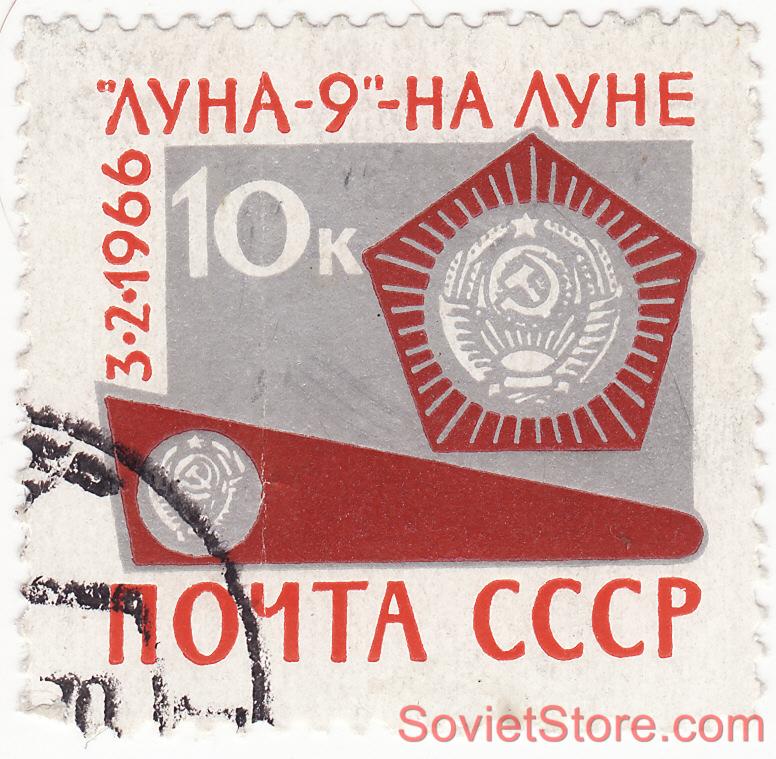SearchProduct Type
|
Add us to: Favorite Stores Item's weight: less then 1 g.
Stamp Authenticity Since 1939 till 1990 Lithuania suffered 3 occupations: 1 German (1941-1944) and 2 Soviet (1939-1941, 1944-1990), one of which lasted 46 years. In WWII occupations were based on violent battles between Germans and Russians. These historical events left a lot of stuff behind them selves. Almost every family in Lithuania has something left, related to USSR history in their forgotten drawers. So we are just traveling around lithuanian countrysides and collecting this memorabilia. Item is original, genuine, authentic, unique, not a copy or replica - has 2-12 decades of it's own unique history.
Luna 9 (E-6 series), also known as Lunik 9 (internal name E-6 N. 13), was an unmanned space mission of the Soviet Union's Luna program. On February 3, 1966 the Luna 9 spacecraft was the first spacecraft to achieve a lunar soft landing and to transmit photographic data to Earth. The automatic lunar station that achieved the soft landing weighed 99 kg. It was a hermetically sealed container with radio equipment, a program timing device, heat control systems, scientific apparatus, power sources, and a television system. The Luna 9 payload was carried to Earth orbit by an A-2-E vehicle and then conveyed toward the Moon by a fourth stage rocket that separated itself from the payload. Flight apparatus separated from the payload shortly before Luna 9 landed. After landing in the Oceanus Procellarum on February 3, 1966, the four petals, which formed the spacecraft, opened outward and stabilized the spacecraft on the lunar surface. Spring-controlled antennas assumed operating positions, and the television camera rotating mirror system, which operated by revolving and tilting, began a photographic survey of the lunar environment. Seven radio sessions, totaling 8 hours and 5 minutes, were transmitted as were three series of TV pictures. When assembled, the photographs provided a panoramic view of the nearby lunar surface. The pictures included views of nearby rocks and of the horizon 1.4 km away from the spacecraft. For unknown reasons, the pictures from Luna 9 were not released immediately by the Soviet authorities. Instead, the Jodrell Bank Observatory, which was monitoring the craft, noticed that the signal format used was identical to the internationally-agreed system used by newspapers for transmitting pictures. The Daily Express rushed a suitable receiver to the Observatory and the pictures from Luna 9 were decoded and published world-wide. The BBC reports speculation that the spacecraft's designers deliberately fitted the probe with equipment that conformed to the standard, specifically to enable reception of the pictures by Jodrell Bank.[1] With this mission, the Soviets accomplished another spectacular first in the space race, the first survivable landing of a humanmade object on another celestial body. Luna 9 was the twelfth attempt at a soft-landing by the Soviets; it was also the first deep space probe built by the Lavochkin design bureau, which ultimately would design and build almost all Soviet (and Russian) lunar and interplanetary spacecraft. All operations prior to landing occurred without fault, and the 58-centimeter spheroid ALS capsule landed on the Moon at 18:45:30 UT on 3 February 1966 west of the Reiner and Marius craters in the Ocean of Storms (at 7°8' north latitude and 64°22' west longitude). Approximately 5 minutes after touchdown, Luna 9 began transmitting data to Earth, but it was 7 hours (after the Sun climbed to 7° elevation) before the probe began sending the first of nine images (including five panoramas) of the surface of the Moon. These were the first images sent from the surface of another planetary body. The radiation detector, the only scientific instrument on board, measured a dosage of 30 millirads (0.3 milligrays) per day [2]. Perhaps the most important discovery of the mission was determining that a foreign object would not simply sink into the lunar dust, that is, that the ground could support a heavy lander. Last contact with the spacecraft was at 22:55 UT on 6 February 1966. SourcesThe free listing tool. List your items fast and easy and manage your active items. On Jul-02-08 at 07:19:30 PDT, seller added the following information:
| Return
Items must be returned within 30 days .
Refund will be given as Money back. Refund policy details: Return is accepted at any reason. Item(s) must arrive to us not later then 30 days after it was shipped out (you will be informed about this immediately after it will be done). Returned items must be the same item in the exact same condition as originally shipped. Refunds are for the final eBay item purchase price only, less a 10% restocking fee. Shipping costs, insurance, and handling charges (if any) are non refundable. Returns must be shipped insured. Shipping
Payment Method
Insurance
Not Offered (Domestic)
|
Shopping Cart |
||||||||||||||||||||||||||||||||||||||||||||||||||||||||||||||||||||||||||||||||||||||||





